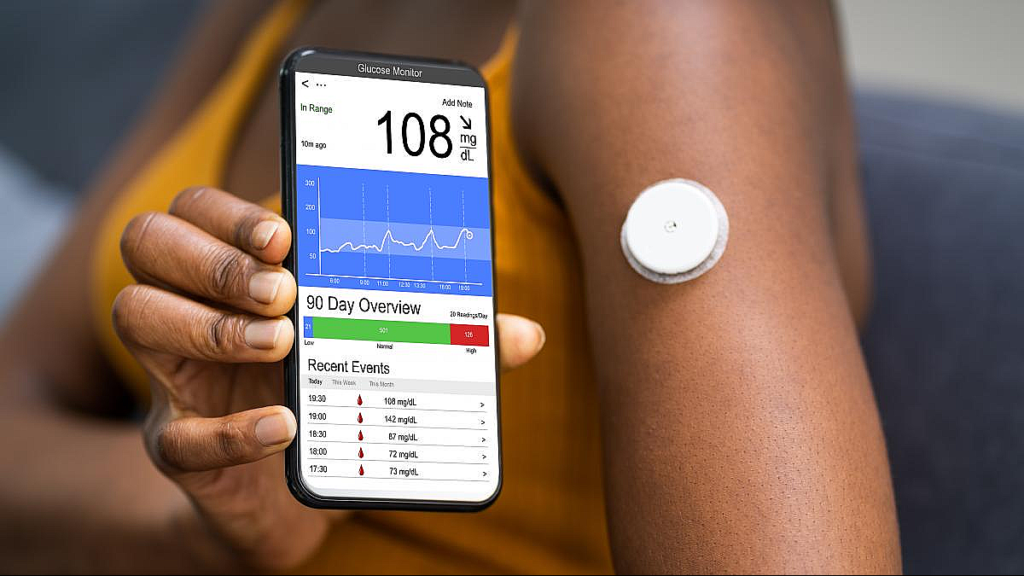Diabetes is a health condition that occurs when your body does not make enough insulin or cannot use it as well as it should. Black adults in the U.S. are 60 percent more likely than white adults to be diagnosed with diabetes. In 2018, non-Hispanic Black people were found to be twice as likely as non-Hispanic white people to die from diabetes. Folks struggling with Type 1 or Type 2 diabetes might sometimes find it challenging to manage their condition.
The continuous glucose monitoring (CGM) system
What is CGM?
Continuous glucose monitoring (CGM) is 24-hour wearable technology that makes tracking your blood sugar or blood glucose levels easier over time.
Insulin is a hormone that helps your body regulate blood sugar levels. If you have Type 1 diabetes, your body doesn’t produce enough (or any) insulin. In Type 2 diabetes, your body makes insulin but doesn’t use it effectively. Folks with diabetes need to give themselves insulin regularly to steady blood sugar levels.
Why do diabetics need to track their blood sugar levels?
Blood sugar levels that go up and down a lot can damage your body in different ways. Blood sugar levels that go way up (hyperglycemia) and way down (hypoglycemia) can damage your body and be life-threatening in some instances. Blood sugar levels can be affected by things like your diet and lifestyle so managing diabetes can be tricky.
Do you need CGM to help manage your diabetes?
Many folks go the fingerstick blood check route and a blood glucose monitor to check their glucose levels. But the fingerstick method only checks blood sugar levels at the moment that it is performed. Consistent monitoring of your blood sugar levels over time with CGM will give you an accurate, more detailed picture of what is happening, thereby helping your doctor develop a better treatment plan for you.
How do CGM devices work?
There are a few CGM devices on the market today, and they all work similarly.
A tiny sensor is placed just under the arm’s or belly’s skin, and adhesive tape secures it. The sensor measures your glucose via your body’s fluids. Many of the devices take readings every five minutes for 24 hours. The sensor does need to be changed about every 7 to 14 days, according to the manufacturer’s suggestions. For those with long-term implantable CGM devices, your physician will change them a few times a year during in-office procedures.
All CGMs use a transmitter to wirelessly send glucose data from the sensor to a device where you can check it. Some CGM systems come with a reusable transmitter; others have a disposable one.
Depending on the CGM system, glucose data from the sensor is sent to a handheld receiver (like a cell phone), smartphone app, or insulin pump.
You can download CGM info (real-time glucose levels, trends, and history) to a computer anytime. Some CGM systems will send data continuously. You can also share the information with your doctor.
Are CGMs easy to use?
A physician prescribes CGMs. Once you get the device, a qualified professional will help you use it properly. Your doctor may recommend taking a diabetes education class or set you up to converse with a certified diabetes tech.
Once you get the hang of using the CGM system, you will need to use it to manage your condition actively.
Will you need to stop doing fingerstick checks?
No. Fingerstick checks are a kind of backup process to also help manage diabetes, so you will still need to use the system. Because fingerstick checks measure glucose levels, they provide the best picture of your level at the exact moment you take it. CGM measures glucose under your skin, which shows where your glucose levels were five to 10 minutes ago.
Fingerstick checks come in handy if, for example, your CGM device shows rising or falling numbers, but you feel fine. It can also provide answers if you don’t feel well, but the CGM says your glucose levels are on target.
How much do CGM devices cost?
CGM devices can cost a pretty penny, but many insurers (including Medicare) cover certain ones. Many health providers and CGM companies also have resources to help make CGM more obtainable for those who need it.
